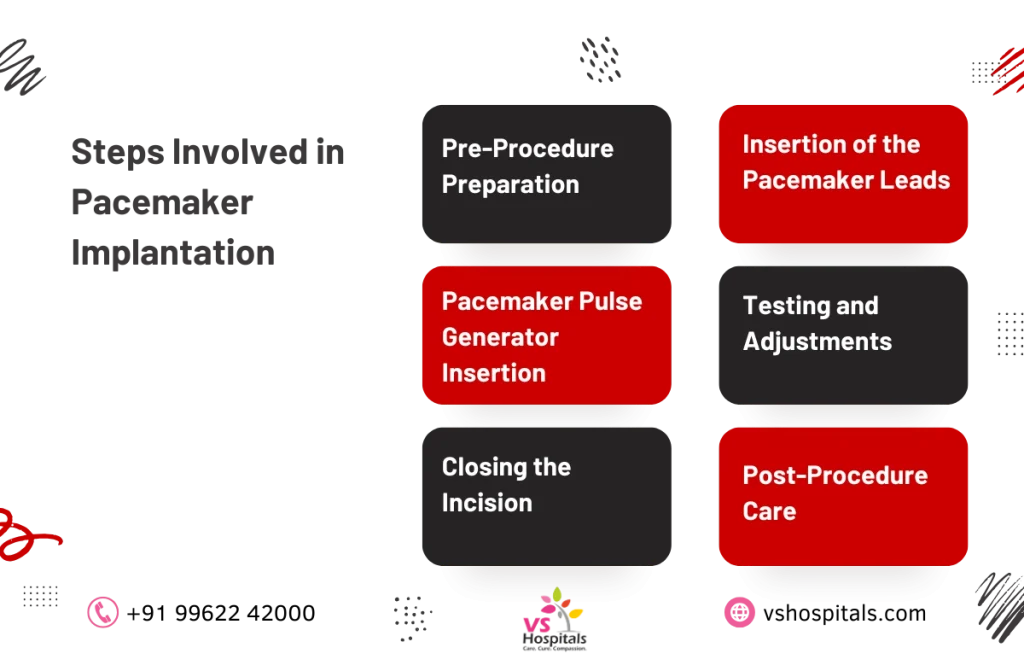Permanent pacemaker implantation is a critical procedure for managing irregular or slow heartbeats, ensuring a healthier and more active life. This advanced treatment helps regulate heart rhythms, improving blood flow and reducing symptoms like fatigue and dizziness. At VS Hospitals, our expert cardiac team combines state-of-the-art technology with personalized care to deliver the best outcomes. Discover how this life-changing procedure can restore your energy and enhance your quality of life.

What is Permanent Pacemaker Implantation?
Permanent pacemaker implantation is a medical procedure where a small, battery-powered device called a pacemaker is surgically placed under the skin of the chest to help regulate abnormal heart rhythms, known as arrhythmias. This device monitors the heart’s electrical activity and delivers electrical impulses to prompt the heart to beat at a normal rate. The procedure involves:
- Insertion of the Pacemaker: The device is implanted under the skin near the collarbone.
- Connection of Leads: Wires, or leads, are threaded through blood vessels to the heart chambers.
- Regulation of Heartbeat: The pacemaker sends electrical signals to maintain a regular heartbeat.
This intervention is essential for individuals experiencing bradycardia (slow heart rate) or other heart rhythm disorders, ensuring the heart beats efficiently and effectively.
How Do Pacemakers Work?
A pacemaker is a small device implanted in the chest to help control abnormal heart rhythms. It monitors the heart’s electrical activity and, when necessary, sends electrical impulses to prompt the heart to beat at a normal rate. This ensures that the heart maintains an appropriate rhythm, effectively supporting the body’s need for blood and oxygen.
- Pulse Generator: Houses the battery and electronic circuitry that generates electrical impulses.
- Leads (Wires): Flexible, insulated wires that deliver electrical impulses from the pulse generator to the heart muscle.
- Electrodes: Located at the end of the leads, they make contact with the heart tissue to monitor and stimulate the heart’s activity.
By coordinating the heart’s electrical signals, pacemakers help maintain a regular heartbeat, preventing symptoms associated with arrhythmias.
Types of Pacemakers
Permanent pacemaker implantation offers different types of pacemaker devices to address specific heart conditions and individual needs. Each type works to regulate heart rhythms effectively, ensuring optimal cardiac performance.
- Single-Chamber Pacemaker: This pacemaker connects to either the right atrium or ventricle, helping regulate simple arrhythmias and maintain a consistent heart rhythm for patients with basic cardiac conditions.
- Dual-Chamber Pacemaker: Synchronizes the right atrium and ventricle, mimicking the heart’s natural rhythm. It’s suitable for patients requiring more advanced regulation of their heartbeat.
- Biventricular Pacemaker (CRT): Used for severe heart failure, it coordinates the left and right ventricles, improving heart efficiency and reducing symptoms like fatigue and breathlessness.
Choosing the right pacemaker device ensures the success of the procedure, improving overall heart function and quality of life.
Pacemaker Surgery
Catheter-Based Approach
The catheter-based approach involves inserting a thin, flexible tube into a blood vessel, typically in the groin or arm, to guide the pacemaker leads to the heart. This minimally invasive method ensures precise placement with less discomfort. It’s ideal for patients requiring quick recovery and fewer risks during surgery with a pacemaker.
Transvenous Approach
In the transvenous approach, the pacemaker leads are threaded through a large vein, usually near the collarbone, and positioned in the heart chambers. This widely used method is performed under local anesthesia, ensuring minimal pain. It is a reliable and efficient way to implant a permanent pacemaker device, offering excellent long-term results.
Surgical (Epicardial) Approach
The surgical-based epicardial approach involves creating a small incision in the chest to place the pacemaker directly on the heart’s surface. This method is often used for patients with unique heart structures or conditions where other methods are unsuitable. While more invasive, it ensures precise device placement and optimal function of a pacemaker.
Risks & Benefits of Pacemakers
Risks of Permanent Pacemaker Implantation
While permanent pacemaker implantation is generally safe, it may involve some risks:
- Infection at the incision site.
- Allergic reactions to medications or the pacemaker device.
- Lead displacement requires repositioning.
These risks are rare and often manageable under expert care at VS Hospitals.
Benefits of Permanent Pacemaker Implantation
The procedure for Pacemaker offers numerous benefits:
- Restores regular heart rhythms.
- Reduces symptoms like fatigue, dizziness, and fainting.
- Enhances overall quality of life.
With cutting-edge technology and expert specialists, VS Hospitals ensures patients experience the maximum benefits of surgery with a pacemaker while minimizing risks.
Conclusion
Permanent pacemaker implantation is a safe and effective procedure that restores a regular heart rhythm, improving overall health and quality of life. By addressing irregular heartbeats, it helps reduce symptoms like fatigue and dizziness, enabling patients to lead more active lives. At VS Hospitals, our skilled specialists and advanced technology ensure exceptional care throughout the process. Take the first step toward better heart health by exploring the benefits of permanent pacemaker implantation with our trusted team.
Read also Coronary Artery Bypass Surgery
